Design does not always turn out the way it was intended. The layout looks good, the color choices seem great, and the CTA balance is smart and clear. But ... It doesn't work. All this or some of the elements and nuances. You're not entirely sure, but something needs to be added.
Despite all good intentions, including all hours of research and analysis, things don't always work out as planned. This is where constant testing begins. One try may not be enough.
More importantly, what your efforts to customize A / B testing doesn't have to be complicated and time-consuming. Here's how to set up a split test in Google Analytics in just a few minutes.
Содержание | Быстрая навигация
What is Google Analytics Content Experiments?
Let's say your online store sells pug greeting cards. Obviously, they have to sell themselves. But let's just assume for a moment that sales are low because you're having trouble getting people to land on individual product pages first.
Your home page isn't your destination - it's a starting point. They come to look, look around and click somewhere else. Most of the time, visitors go to your product, service, or About page.
Regardless of where readers are clicking, the goal is to get them into the funnel or path as quickly as possible: A to help them find what they were looking for, and B to get them closer to launching one of your conversion events.
The magic happens on the landing page, where the two - visitor interest and your marketing goal - intertwine and become one in a beautiful symphony.
So let's try out a few homepage variations to see which ones best drive new visitors to your top selling products. One has a video, the other does not. One is short and concise, the other is long and detailed. One has a GIF, the other does not.
New inbound traffic is split between these page variations. This allows you to observe and compare the number of people performing a desired action until you can confidently announce the best design option.
Doing a simple split test like this is Landing Page Optimization 101. There, you define the specific page variables that lead to the best results for your audience and multiply them on your site. Google Analytics comes with a basic content experimentation feature. It allows you to:
- compare different page options,
- split traffic appropriately,
- receive email updates on trends in results and whether you are about to achieve your goal or not.
But ... technically this is not a simple A / B test. This is actually good. Why content experimentation can be better than traditional A / B tests?
Your typical A / B test selects a very specific element of the page, such as the title. It only changes this tiny variable in new page variations.
This web is full of articles where switching the button color resulted in a 37.596% * increase in CTR because people like green buttons instead of blue ones.
(* These are fictional numbers)
Several problems with classic A / B testing in Google Analytics.
First, tiny changes often bounce back to the mean. So while you may see a few small fluctuations when you first run the test, small changes are usually only equal to small results.
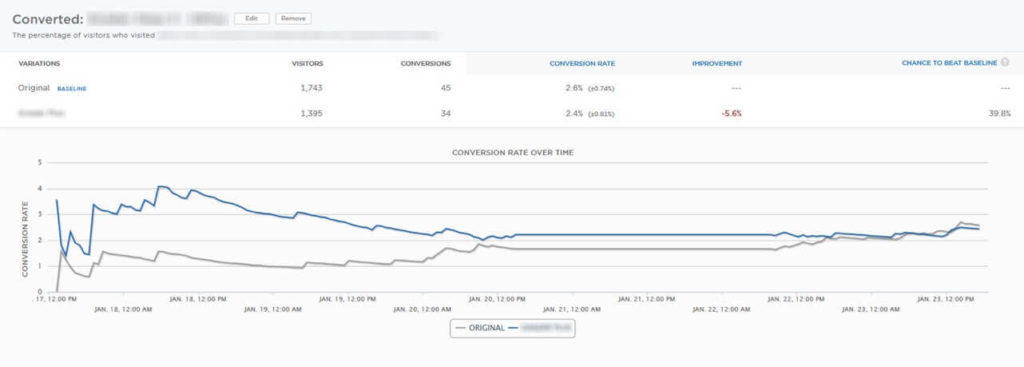
The second problem is that most A / B tests fail.
And if that wasn't enough, then the third problem is that you'll need a ton of volume, specifically 1,000 monthly conversions to get started, and testing at least 250 conversions to determine if these changes actually work or not.
Google Analytics content experiments use the A / B / N model instead. It's like a step between A / B tests with only one variable and multivariate tests with coordinated multiple variables.
After typing this last sentence, I realized that only hardcore CRO fans would care about this distinction. However, it is still important to understand from a high level so that you know what types of changes to make, try, or test.
You can create up to 10 different versions of a page, each with its own unique content or changes. In other words, you can test material with a large image.
For example: "Does a positive or negative Pug result in more clicks?"
Typically, these holistic changes can be more useful. They help you figure out what messages or page elements you can carry over to your other marketing materials such as emails, social media, and more.
You can use Google Analytics Content Experiments to make faster iterative changes and learn The-Go. Here's how to get started.
How to set up Google Analytics experiments.
Setting up content experiments takes only a few seconds. However, before logging in, you will need to configure at least one or two page variations. This topic is outside the scope of this area, so check one and the other to determine which one you should be testing first.
Once you are set up and ready to go, log into Google Analytics and proceed with the next steps.
Step 1. Beginning.
Deep in the section "Behavior" Google Analytics - you know, what you ignore when switching between Acquisitions and Conversions is the vague but harmless sound of "Experiment".
Most likely, when you click on it, you will see a blank screen that looks like this:
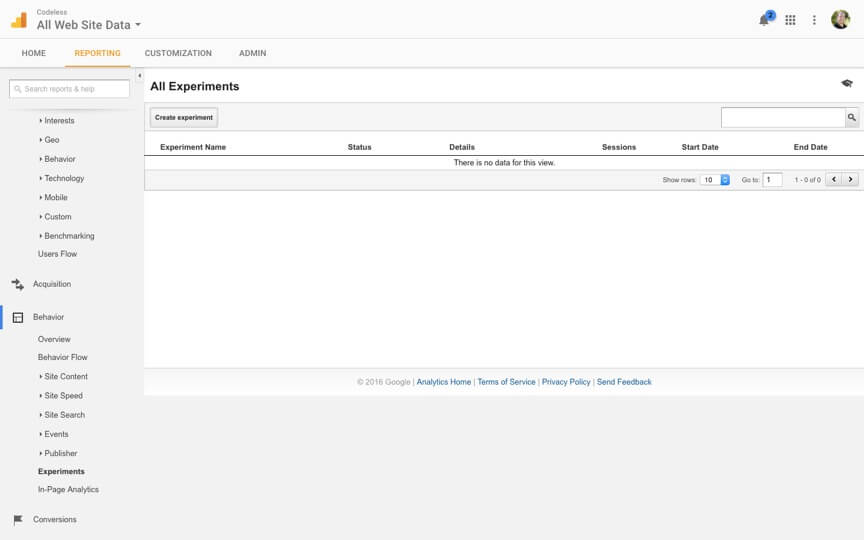
To create your first experiment, click the button "Create an experiment" in the upper left corner of the window.
Let's see what the creation looks like.
Step 2. Select an experiment.
Ok, now the fun begins. Name your experiment whatever you like. And look down at the target selection. Here you can set an identifiable outcome to track your results and determine the winning option.

You have three options here. You can:
- Select an existing goal, such as subscriptions, purchases, etc.
- Indicate an indicator of website usage, for example, a bounce rate;
- Create a new goal, or if you don't already have one, but want to run a conversion experiment.
The choice depends entirely on why you are doing this test in the first place.
for example: Most are surprised that their old blog posts often bring in the most traffic. Problem? Many times, those old, obsolete pages also have the highest bounce rates.
Navigate to: Behavior> Secondary Measurements + Google / Organic> Popular Pageviews> Bounce Rate.
Here's an example:
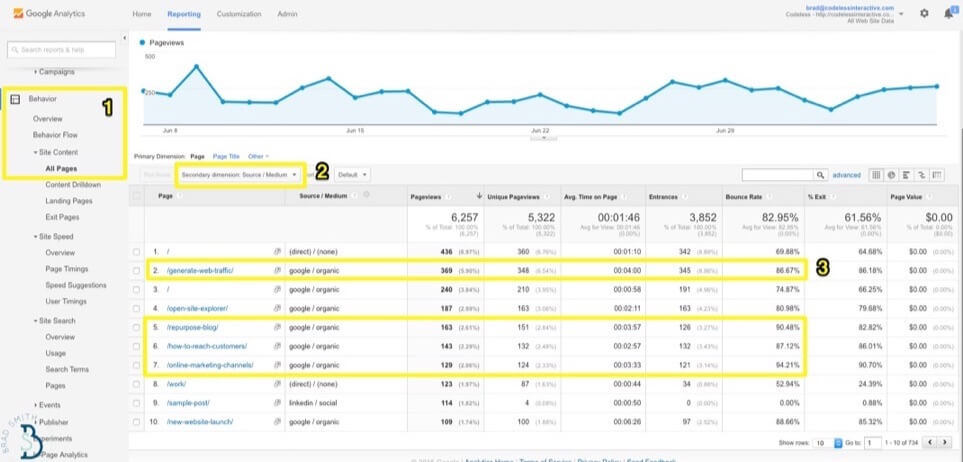
Here are some other useful Google Analytics reports that will let you find similarly low results when you're done setting up your experiment.
Let's set bounce rate as our goal for now, so we can make changes to the page layout or increase the volume and quantity of high-quality visuals.
After selecting the target, you can click on "Extra options"to get more detailed settings for this test.

By default, these advanced options are disabled and Google will "dynamically adjust traffic based on the performance of the options." However, if enabled, your experiment will be:
- just distribute traffic evenly across all the page variations you add,
- conduct an experiment for two weeks,
- obtain the statistical confidence level 95%.
These are all good places to start most of the time, however you can change the duration depending on how much traffic you get. That is, you can get away with shorter tests if there is a ton of traffic on this page, or if you need to, extend it for more than two weeks. This is necessary when there is only a slow trickle of visitors, and not a stormy stream.
So far, so good!
Step 3. Set up your experiment.
The next step is to simply add URLs for all of the page variations that you want to test.
Literally just copy and paste:
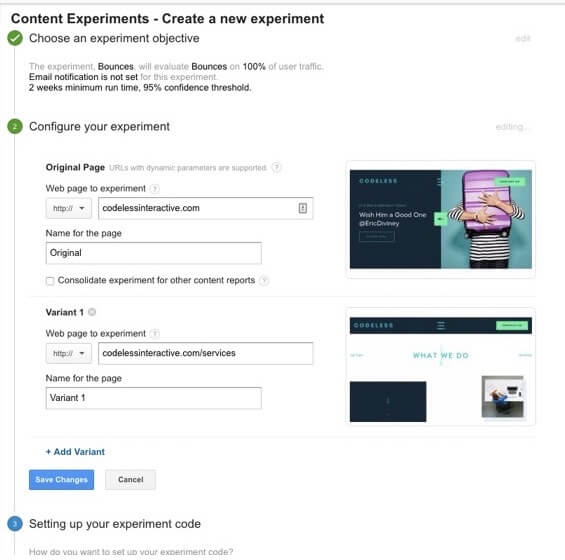
You can also give them useful names to remember. Or not. He just numbers the options for you.
Step # 4. Adding script code to your page.
Now everyone's favorite part is editing your page code!
The good news is that the first thing you'll see in this section is a useful toggle button that just sends all that pesky code to your favorite techie.
If you want to get your hands dirty, read on.

First of all, double check all the pages you plan to test. This will ensure that the default Google Analytics tracking code is installed. If you are using a CMS, this is how it should be, as it is usually initially added for the entire site.
Then highlight and copy the provided code.
You will need to find the original opening title tag, which should be located literally at the top of the HTML document. Search to make it easier:
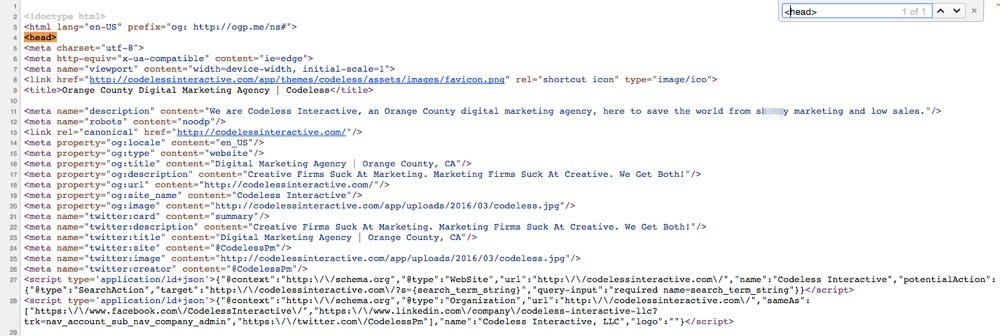
Then press "Next step" at Google Analyticsso that they can make sure everything is in order. Not sure if you did the right thing? Don't worry, they will tell you.
For example, when I first tried to install the code for this demo, I accidentally placed it under the regular Google Analytics tracking code that they pointed out so diligently and clearly.

After double checking your work and fixing it, you should see this:

And now you're ready to go!
See, it's not that bad now ?!
Conclusion on working with the A / B test.
Websites are never really finished and complete. They need iteration, including constant analysis, new ideas and changes, to continually increase results.
This often means analyzing and testing entire pages based on large and small changes such as value propositions or layouts. This is what will give the same great results.
Landing page optimization and split testing techniques can get extremely confident and require dedicated tools that only CRO professionals can navigate.
Google Analytics includes its own simple option for split testing in content experiments.
Assuming that you already have new page variations created, and you can safely edit the code of your site. It only takes a few seconds before getting started. And they can enable anyone in your organization to move from research to action by the end of the day.
Based on materials from the site: neilpatel.com
✓ What else can you use an A / B test in Google Analytics for?
It helps you find out what your visitors are responding to best. A / B test allows you to assess interaction with the audience, find out from which sources the most visitors and personalize the site for traffic sources.
When is A / B testing used?
A / B test is done both when creating a site from scratch and when making changes to existing pages. You can check in advance whether the innovations will be effective or which of the options will attract more of the target audience.
✓ How to work with hypotheses when there are several of them?
Better to test hypotheses one at a time. This will help evaluate the effectiveness of each. If you run several at once, it will not be clear which one gave the desired results.
✓ How long should A / B testing in Google Analytics take?
Testing too short may not show real results.
✓ What is A / B Testing in Google Ads?
AdWords A / B Testing or A / B Testing helps you test and evaluate your campaign with an alternate set of settings. This is possible through AdWords Experiments, which allows advertisers to make changes without modifying an existing campaign.
✓ How do I know if my ad is showing on Google?
Sign in to your Google Ads account.
Click Ads & Extensions in the page selection menu to view a list of your ads.
To check the status of an ad or extension, just look in the "Status" column. If you hover over each status, you will see a more detailed explanation of what the status means.
✓ Is Google Optimization Free?
There are two versions of Google Optimize. Optimization is a free product that lets you start experimenting. Optimize 360 is a premium testing and personalization tool for enterprises and is part of the Google Marketing Platform.





2 thoughts on “Как запустить A/B тест в Google Analytics.”